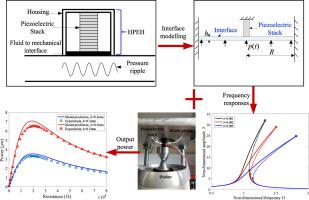当前位置:
X-MOL 学术
›
Mech. Syst. Signal Process.
›
论文详情
Our official English website, www.x-mol.net, welcomes your feedback! (Note: you will need to create a separate account there.)
Modelling of the circular edge-clamped interface of a hydraulic pressure energy harvester to determine power, efficiency and bandwidth
Mechanical Systems and Signal Processing ( IF 8.4 ) Pub Date : 2021-01-01 , DOI: 10.1016/j.ymssp.2020.107013 Huifang Xiao , Haotang Qie , Chris R Bowen
Mechanical Systems and Signal Processing ( IF 8.4 ) Pub Date : 2021-01-01 , DOI: 10.1016/j.ymssp.2020.107013 Huifang Xiao , Haotang Qie , Chris R Bowen

|
Abstract There is an increasing desire to monitor and control hydraulic systems in an autonomous and battery-free manner. One solution to this challenge is to harvest hydraulic pressure ripples and noise by exploiting the piezoelectric effect. This paper develops a new generalized model of a hydraulic piezoelectric harvester based on a circular edge-clamped flat plate interface with a central piezoelectric stack. Such a model allows the relationships between harvesting performance and structure to be assessed in detail. It is demonstrated that the force-deflection relationship of a circular edge-clamped plate with a central lumped mass follows a cubic hardening Duffing equation. A single degree of freedom (SDOF) lumped-parameter model of the system is established where the nonlinear frequency response resulting from hardening nonlinearities are explored. The input mechanical energy and the output electrical energy both exhibit a quadratic nonlinear relationship with vibration amplitude. The maximum output occurs at the jump-down frequency and the overall energy conversion efficiency of the system is determined. The optimum resistance load for maximum output energy and energy efficiency are obtained as non-dimensional excitation frequency. Experimental validation is performed and good agreement is observed between model results and experimental measurements. The developed model provides important insights into the optimization of power output and response of future hydraulic energy harvesting devices.
中文翻译:

液压能量采集器圆形夹边界面的建模以确定功率、效率和带宽
摘要人们越来越希望以自主和无电池的方式监测和控制液压系统。解决这一挑战的一种方法是利用压电效应收集液压脉动和噪声。本文开发了一种基于圆形夹边平板接口和中心压电堆栈的液压压电采集器的新广义模型。这样的模型允许详细评估收割性能和结构之间的关系。证明了具有中心集中质量的圆形边缘夹紧板的力-挠度关系遵循三次硬化 Duffing 方程。建立了系统的单自由度 (SDOF) 集总参数模型,其中探索了由硬化非线性引起的非线性频率响应。输入机械能和输出电能均与振动幅度呈二次非线性关系。最大输出出现在跳降频率处,并确定系统的整体能量转换效率。获得最大输出能量和能量效率的最佳电阻负载作为无量纲激励频率。进行了实验验证,并在模型结果和实验测量之间观察到了良好的一致性。开发的模型为优化功率输出和未来液压能量收集装置的响应提供了重要见解。输入机械能和输出电能均与振动幅度呈二次非线性关系。最大输出出现在跳降频率处,并确定系统的整体能量转换效率。获得最大输出能量和能量效率的最佳电阻负载作为无量纲激励频率。进行了实验验证,并在模型结果和实验测量之间观察到了良好的一致性。开发的模型为优化功率输出和未来液压能量收集装置的响应提供了重要见解。输入机械能和输出电能均与振动幅度呈二次非线性关系。最大输出出现在跳降频率处,并确定系统的整体能量转换效率。获得最大输出能量和能量效率的最佳电阻负载作为无量纲激励频率。进行了实验验证,并在模型结果和实验测量之间观察到了良好的一致性。开发的模型为优化功率输出和未来液压能量收集装置的响应提供了重要见解。最大输出出现在跳降频率处,并确定系统的整体能量转换效率。获得最大输出能量和能量效率的最佳电阻负载作为无量纲激励频率。进行了实验验证,并在模型结果和实验测量之间观察到了良好的一致性。开发的模型为优化功率输出和未来液压能量收集装置的响应提供了重要见解。最大输出出现在跳降频率处,并确定系统的整体能量转换效率。获得最大输出能量和能量效率的最佳电阻负载作为无量纲激励频率。进行了实验验证,并在模型结果和实验测量之间观察到了良好的一致性。开发的模型为优化功率输出和未来液压能量收集装置的响应提供了重要见解。
更新日期:2021-01-01
中文翻译:

液压能量采集器圆形夹边界面的建模以确定功率、效率和带宽
摘要人们越来越希望以自主和无电池的方式监测和控制液压系统。解决这一挑战的一种方法是利用压电效应收集液压脉动和噪声。本文开发了一种基于圆形夹边平板接口和中心压电堆栈的液压压电采集器的新广义模型。这样的模型允许详细评估收割性能和结构之间的关系。证明了具有中心集中质量的圆形边缘夹紧板的力-挠度关系遵循三次硬化 Duffing 方程。建立了系统的单自由度 (SDOF) 集总参数模型,其中探索了由硬化非线性引起的非线性频率响应。输入机械能和输出电能均与振动幅度呈二次非线性关系。最大输出出现在跳降频率处,并确定系统的整体能量转换效率。获得最大输出能量和能量效率的最佳电阻负载作为无量纲激励频率。进行了实验验证,并在模型结果和实验测量之间观察到了良好的一致性。开发的模型为优化功率输出和未来液压能量收集装置的响应提供了重要见解。输入机械能和输出电能均与振动幅度呈二次非线性关系。最大输出出现在跳降频率处,并确定系统的整体能量转换效率。获得最大输出能量和能量效率的最佳电阻负载作为无量纲激励频率。进行了实验验证,并在模型结果和实验测量之间观察到了良好的一致性。开发的模型为优化功率输出和未来液压能量收集装置的响应提供了重要见解。输入机械能和输出电能均与振动幅度呈二次非线性关系。最大输出出现在跳降频率处,并确定系统的整体能量转换效率。获得最大输出能量和能量效率的最佳电阻负载作为无量纲激励频率。进行了实验验证,并在模型结果和实验测量之间观察到了良好的一致性。开发的模型为优化功率输出和未来液压能量收集装置的响应提供了重要见解。最大输出出现在跳降频率处,并确定系统的整体能量转换效率。获得最大输出能量和能量效率的最佳电阻负载作为无量纲激励频率。进行了实验验证,并在模型结果和实验测量之间观察到了良好的一致性。开发的模型为优化功率输出和未来液压能量收集装置的响应提供了重要见解。最大输出出现在跳降频率处,并确定系统的整体能量转换效率。获得最大输出能量和能量效率的最佳电阻负载作为无量纲激励频率。进行了实验验证,并在模型结果和实验测量之间观察到了良好的一致性。开发的模型为优化功率输出和未来液压能量收集装置的响应提供了重要见解。



























 京公网安备 11010802027423号
京公网安备 11010802027423号